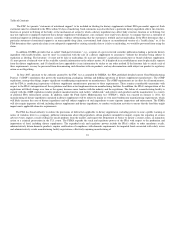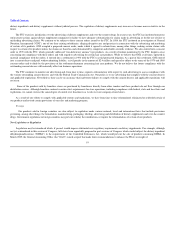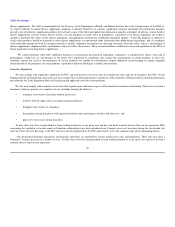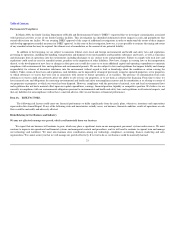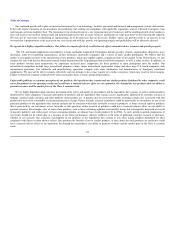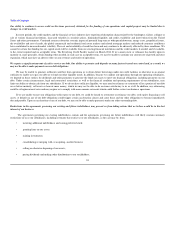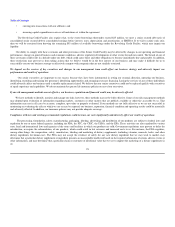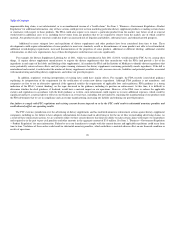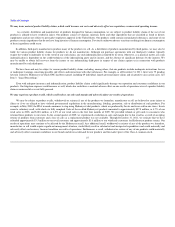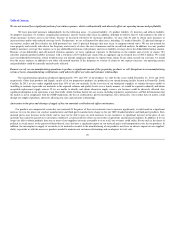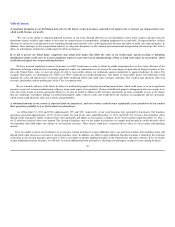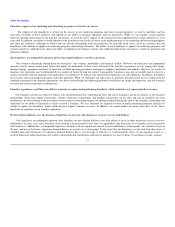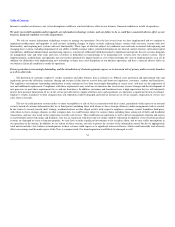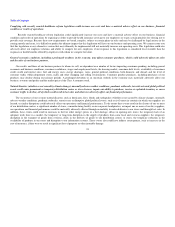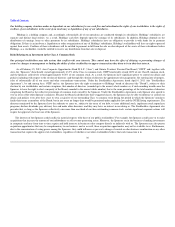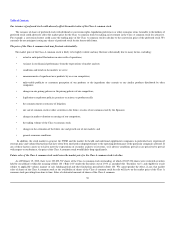GNC 2012 Annual Report Download - page 30
Download and view the complete annual report
Please find page 30 of the 2012 GNC annual report below. You can navigate through the pages in the report by either clicking on the pages listed below, or by using the keyword search tool below to find specific information within the annual report.
Table of Contents
As is common in our industry, we rely on our third-party vendors to ensure that the products they manufacture and sell to us comply with all applicable
regulatory and legislative requirements. In general, we seek representations and warranties, indemnification and/or insurance from our vendors. However,
even with adequate insurance and indemnification, any claims of non-compliance could significantly damage our reputation and consumer confidence in our
products, and materially and adversely affect the market price of the Class A common stock. In addition, the failure of such products to comply with
applicable regulatory and legislative requirements could prevent us from marketing the products or require us to recall or remove such products from the
market, which in certain cases could materially and adversely affect our business, financial condition and results of operation. For example, we sell products
manufactured by third parties that contain derivatives from geranium, known as 1.3-dimethylpentylamine/dimethylamylamine/13-dimethylamylamine
("DMAA"). Although we have received representations from our third-party vendors that these products comply with applicable regulatory and legislative
requirements, recent media articles have suggested that DMAA may not comply with DSHEA. In December 2011, the U.S. military asked us to temporarily
remove products containing DMAA from our stores on its bases pending the outcome of a precautionary review. That review is still pending. If it is
determined that DMAA does not comply with applicable regulatory and legislative requirements, we could be required to recall or remove from the market all
products containing DMAA and we could become subject to lawsuits related to any alleged non-compliance, any of which could materially and adversely
affect our business, financial condition and results of operations. In the past, we have attempted to offset any losses related to recalls and removals with
reformulated or alternative products; however, there can be no assurance that we would be able to offset all or any portion of such losses related to any future
removal or recall.
Our operations are subject to environmental and health and safety laws and regulations that may increase our cost of operations or expose us to
environmental liabilities.
Our operations are subject to environmental and health and safety laws and regulations, and some of our operations require environmental permits and
controls to prevent and limit pollution of the environment. We could incur significant costs as a result of violations of, or liabilities under, environmental laws
and regulations, or to maintain compliance with such environmental laws, regulations or permit requirements. For example, in March 2008, the DHEC
requested that we investigate contamination associated with historical activities at one of our South Carolina facilities. These investigations have identified
chlorinated solvent impacts in soils and groundwater that extend offsite from our facility. We are continuing these investigations in order to understand the
extent of these impacts and develop appropriate remedial measures for DHEC approval. At this stage of the investigation, however, it is not possible to
accurately estimate the timing and extent of any remedial action that may be required, the ultimate cost of remediation or the amount of our potential liability.
In addition to the foregoing, we are subject to numerous federal, state, local and foreign environmental and health and safety laws and regulations
governing our operations, including the handling, transportation and disposal of our non-hazardous and hazardous substances and wastes, as well as emissions
and discharges from its operations into the environment, including discharges to air, surface water and groundwater. Failure to comply with such laws and
regulations could result in costs for remedial actions, penalties or the imposition of other liabilities. New laws, changes in existing laws or the interpretation
thereof, or the development of new facts or changes in their processes could also cause us to incur additional capital and operating expenditures to maintain
compliance with environmental laws and regulations and environmental permits. We also are subject to laws and regulations that impose liability and cleanup
responsibility for releases of hazardous substances into the environment without regard to fault or knowledge about the condition or action causing the
liability. Under certain of these laws and regulations, such liabilities can be imposed for cleanup of previously owned or operated properties, or for properties
to which substances or wastes that were sent in connection with current or former operations at its facilities. The presence of contamination from such
substances or wastes could also adversely affect our ability to sell or lease our properties, or to use them as collateral for financing.
28


